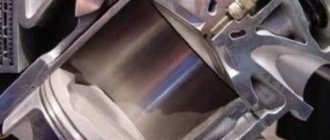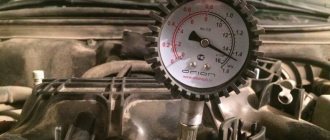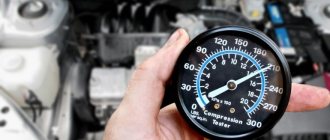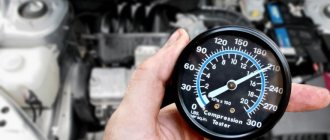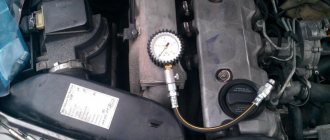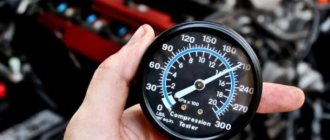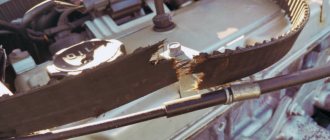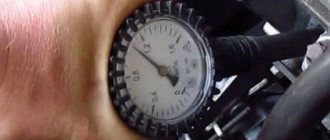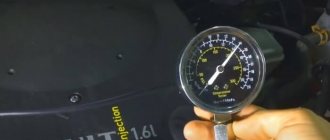Compression in an internal combustion engine (ICE) is an increase in air pressure in the cylinder during the compression stroke , that is, when the piston moves up to top dead center (TDC). If there is no compression in the cylinders or it is close to a critical value, many problems arise that make the operation of the power unit difficult, and sometimes make it impossible. Loss of power, excessive consumption of fuel and oil, difficult starting, misfiring - these are symptoms that directly indicate depressurization of one or more cylinders. In the article we will tell you how to increase the service life of the engine, when and how to carry out diagnostics.
Navigation
Self-diagnosis of decreased compression pressure Diagnostics using a maximeter Reduced compression Human factor Mechanical damage Reduced compression in DSV Decarbonization of compression rings Prevention of decreased compression pressure
Signs of decreased or lack of compression in the cylinders
List of possible “symptoms” of lack of compression in one, two or all cylinders of the internal combustion engine (internal combustion engine) of a vehicle:
- A malfunction of a diesel or gasoline engine, in which the power unit stops “pulling” - it does not start or starts with difficulty. The engine can be started by cranking the crankshaft for a long time using the starter mechanism. The inability to start is due to the fact that one of the cylinders (or all at once) has low pressure or it is zero.
- Engine operation has become unstable. The revolutions of the power unit float when idling, and while driving at speed they will be unstable. Different compression leads to a loss of normal power or to the fact that this parameter is completely absent after overheating or when cold.
- Increased fuel consumption.
- Problems with the cylinders. If the compression is bad and continues to fall, when driving uphill, a knocking sound from the hydraulic compensators appears (the “clatter” of metal under the hood). This problem is especially obvious if you drive with an injector or carburetor at low speeds.
- On diesel engines, the malfunction is accompanied by popping noises appearing in the internal combustion engine.
- With low compression in 1, 4 or other cylinders (up to 3, 5, 6, 7, 8, 9 atm (atmospheres)), the pressure level in the cooling system lines may increase. This will cause the system to begin to squeeze out refrigerant from under the sealing components. If there is no coolant and the car has leaks, it is necessary to test the compression in the third, fourth and other cylinders.
- The appearance of exhaust gases escaping in the engine compartment from the connection of the cylinder head (cylinder head) with the main module. This problem is usually due to damage or wear to the gasket.
Error code
It is important to know
P030X is an error code that appears when compression in one or more cylinders decreases on most modern cars.
This combination appears when there is a malfunction in the ignition system. Instead of the X symbol, the diagnostic equipment displays the number of the cylinder (for example, 10 or 16) in which the error was registered.
Video: what is the reason for the lack of compression
User Alexander Stepanov spoke about the “symptoms” and reasons why there is no compression in the engine cylinders
Mechanical problems
If a 4-cylinder or larger power unit works, but there is no compression, then the reasons may be mechanical. Compression suddenly disappears for one of the following reasons:
- The exhaust valves are most often damaged. Cracks can often be observed on the valve. This is due to natural wear and tear on the engine. The valve does not fit sufficiently against the seat in the cylinder head. That's why there is no compression in cylinder 2.
- Also one of the reasons is wear of the valve seat. Reduced or absent compression is explained by mechanical damage. Often the saddle is pressed through.
- A popular reason is a burnt gasket between the engine block and the head. Experts are sure that this is an inevitable situation, which occurs due to the high mileage of the car. A little less often, the cause of gasket burnout is dirt getting on the plane. This problem is encountered when the engine is operated for a long time at elevated temperatures. The cylinder head cracks and the block becomes deformed.
- Mechanical reasons for low compression include scuffing in the combustion chambers. There are many reasons for the formation of scuffing, but the most common is overheating. If the piston ring inside the cylinder breaks, this leads to scoring. Damage to parts of the CPG also leads to a decrease in compression. For example, inter-ring bridges on pistons often break.
- If the timing belt breaks, there will be no pressure in all cylinders and the engine will not be able to start.
- Intake valves fail. Cracks form on the pistons or cylinder walls. Carbon deposits appear on valve seals and rings. All this helps reduce compression.
A sharp drop in compression can lead to very serious problems in the operation of the power unit. If there is no pressure in one of the cylinders, then diagnostics must be performed. Next, we'll look at how to check compression in cylinders.
Why did the compression disappear?
An increased or decreased compression ratio in two, three or one cylinder can be associated with mechanical or non-mechanical faults.
Non-mechanical damage
Such problems include mistakes made during a poorly carried out “overhaul” (overhaul of the motor). It is possible that the valve timing was adjusted incorrectly and the valve elements are not closing at the right time. During the compression stroke, due to clamped valves, the piston group does not work correctly, as a result of which compression is lost. As a result, some of the air leaves the system.
The cause of the malfunction may be due to coking and sticking of the piston rings. Such a malfunction leads to the fact that the valves, which are clamped while the engine is running, can allow gases to pass through the sealing elements. The valve stem seals work without failure, but the lubricating fluid cannot properly fill all the cracks formed in the system. As a result, the consumable material is lubricated from the walls of the motor with the remains of the combustible mixture.
Mechanical damage, wear
List of mechanical reasons why compression in the engine cylinders could critically drop or fail:
- Broken or worn exhaust valve. Cracks form on the inlet valve, and the device itself may not adhere sufficiently to the working surface. The problem may appear suddenly; before this, incorrect pressure in the compressor does not affect the operation of the car in any way.
- If compression drops sharply, this may be due to valve seat failure.
- Malfunction of the camshaft associated with its assembly or overhaul. Incorrect actions during overhaul will lead to rapid wear of the unit.
- Damage or wear to the cylinder head gasket. This problem is often a consequence of natural shock absorption or dirt getting on the surface of the sealing component.
- Gasoline hydraulic shock.
- Seizure of cylindrical elements associated with overheating of the power unit.
- Worn timing belt or chain. This product belongs to the category of consumables, so it must be changed periodically. The timing chain may cause damage to the engine valves.
- Intake valve malfunction. A
- Clogged injectors. The problem manifests itself in the same way both hot and cold. Due to the injectors, a complete stop of the power unit is possible.
- Failure or natural wear of the elements of the cylinder-piston group.
- The appearance of cracks and other defects on the pistons or cylinders of the engine.
- Wear or breakage of the inter-ring bridges of the pistons.
Let's sum it up
Taking into account the above, it becomes clear that if the compression in the cylinders has dropped not due to a burnt-out valve or problems with the gasket, then more serious engine repairs cannot be avoided.
Finally, we note that in order to avoid problems with compression on relatively “fresh” engines, it is necessary to pay attention to the quality of fuel and oil, driving style and operating conditions of the vehicle, as well as monitor the condition and performance of the power system. In other words, it is necessary to avoid active carbon formation in the cylinders, since coke and deposits often cause sticking of rings and coking of valves.
Compression in a car engine: what it affects and how to check. How to check compression without a compression meter, take readings using a device.
Determination of the condition and degree of wear of the engine. What signs indicate severe wear of the internal combustion engine. Methods of checking and diagnosing the condition of the motor.
Features and procedure for independently measuring the exact compression of a diesel and gasoline engine. Compression “cold” and “hot”, malfunctions.
High compression in the engine and the main reasons for increased compression. Why does compression also decrease across the cylinders? Tips and tricks.
Diesel engine compression indicator. The main reasons and main signs of decreased compression. Starting the engine with insufficient pressure in the cylinders.
Problems starting a diesel engine. Signs of low compression and causes of malfunction: timing belt, cylinder mirror, piston and rings. We measure the compression.
Source
How to check the level?
To find out about small or weak compression on spark plugs in the first, second or other cylinder of the engine, you must adhere to the following rules:
- the power unit must be spun up by the starter to extremely high speeds, for this it is necessary to reduce the likelihood of energy loss;
- the procedure should not be carried out on a cold engine in order to ensure maximum coupling at temperatures closest to operating temperatures;
- You must first turn off and unscrew the spark plugs from the cylinders to prevent the formation of resistance to rotation;
- you need to turn off the fuel supply so that the engine fluid is not washed off the cylinder walls;
- It is necessary to charge the battery as much as possible to effectively spin the crankshaft.
Using a compression gauge
To check the compression level using a compression meter:
- You need to warm up the car to operating temperature
- Relieve the pressure level in the fuel rail. Afterwards, you need to start the power unit again.
- The next stage of diagnosis, which will allow us to understand the cause of the drop in compression, will be the removal of the tips located on the spark plugs.
- At the next stage, you need to check whether the compression has dropped in all four cylinders of the engine.
Table: measurement results
| Cause of the problem | Symptoms of a problem | Compression level, MPa | |
| The damper is fully open | The damper is closed | ||
| The power unit is working properly | — | 1,0-1,2 | 0,6-0,8 |
| Crack or other defect in the piston bridge | the appearance of blue smoke from the muffler, increased pressure in the crankcase | 0,6-0,8 | 0,3-0,4 |
| Piston burnout |
| 0,5-0,5 | 0-0,1 |
| Rings sticking in piston grooves |
| 0,2-0,4 | 0-0,2 |
| Piston element and cylinder scuffing |
| 0,2-0,8 | 0,1-0,5 |
| Valve deformation | One or more engine cylinders cannot operate at low speeds | 0,3-0,7 | 0-0,2 |
| Valve burnout | One or more engine cylinders cannot operate at low speeds | 0,1-0,4 | 0 |
| Valve sticking | One or more engine cylinders cannot operate at low speeds | 0,4-0,8 | 0,2-0,4 |
| The appearance of a defect on the camshaft cam profile (for engines equipped with hydraulic tappets) | One or more engine cylinders cannot operate at low speeds | 0,7-0,8 | 0,1-0,3 |
| An increase in the volume of deposits and soot in the combustion chamber along with wear of the rings and valve stem seals | Increased consumption of engine fluid, blue smoke coming from the exhaust pipe | 1,2-1,5 | 0,9-1,2 |
| Natural wear of piston group elements | Increased consumption of engine fluid, blue smoke coming from the exhaust pipe | 0,6-0,9 | 0,4-0,6 |
Oil check
The oil test is carried out using 15-20 grams of lubricant, which is poured into an incorrectly operating cylinder.
Then you need to check:
- thermal clearances of valves on each cylinder;
- motor;
- lubricant.
Then the engine is assembled and started, and the cooling system expansion tank is diagnosed.
Video: checking compression without using a compression gauge
The Secret GARAGE channel presented a video showing a way to check the pressure in the engine cylinders without using compression equipment.
Oil check
Diagnostics can be performed using motor fluid. But for this you will still need a compression gauge:
- Open the hood and disconnect the high voltage wires from the spark plugs.
- Unscrew them from their seats. Pour 30-50 grams of motor oil into the sockets where they are installed.
- Carry out a pressure diagnostic with the device. If the operating parameter has increased, and there is no difference in performance between the cylinders, then repair the seals or rings. They could have coked up. You can replace them yourself. In the case of rings, you will have to remove and disassemble the block head.
1. Filling oil into spark plug holes
2. Diagnostics of compression with the device
How to increase compression in cylinders yourself?
If the compression is below the normalized value, then it can be increased in several ways:
- If the valves are incorrectly adjusted in 2 or other cylinders, then adjusting them will solve the problem of low compression. If the thermal clearances are not set to normal and the motor does not work, you will have to change the valves and grind them in.
- A damaged cylinder head gasket must be replaced.
- If the problem is the appearance of defects on the block head as a result of overheating, then the easiest way to increase compression is by trimming the surface of the unit. Serious defects in the body of the device can only be eliminated by replacing it.
What will you need?
To carry out decoking you will need:
- alcohol;
- kerosene;
- gloves;
- spark plug key.
Algorithm of actions
Guide to increasing compression level:
- At the first stage, pure alcohol and kerosene are mixed in a 1:1 ratio. 50 grams of the resulting composition is poured into each engine cylinder.
- The engine is started, the motor must warm up to operating temperature.
- Then the high-voltage wires are disconnected and the spark plugs are unscrewed using a special wrench. A mixture of alcohol and kerosene is poured into each cylinder.
- After adding the composition, the car must sit for at least ten hours.
- Then approximately 20 grams of oil is poured into each cylinder and the engine is started. The engine must run for at least 20 minutes. If the deposit on the walls was not critical, then most of it will be removed.
Debugg
Eliminating the causes of a drop in compression in one of the cylinders directly depends on what was to blame for its occurrence.
Most often, this problem occurs due to the occurrence of rings. The formation of carbon deposits (coking) in one of the cylinders occurs due to the penetration of a large amount of oil into it.
For example, this can happen if the valve stem seals for that cylinder are damaged.
The difficulty of repairing compression loss caused by rings depends on the nature of the damage.
If they just lay there, then you can try to decarbonize them. But if the rings burst, then you will have to disassemble almost the entire engine to replace the damaged elements.
The same applies to valves. If they are misadjusted, it is enough to bring the thermal gaps back to normal. But if the valves and their seats are burnt, then repair work is carried out on the cylinder head - the valves are changed and they are ground in.
Regarding the cylinder head gasket, if it’s all because of it, then they change it. But with the block head, not everything is so simple.
If it was caused by overheating, then you can still fix the problem by trimming the surface.
But if defects form in the body of the head, it is replaced. Any piston malfunction is definitely a replacement.
POPULAR WITH READERS: What oils should be poured into the engine
What could be the consequences of low or no compression?
If the pressure drop in one or more engine cylinders is critical, then the problem may be due to engine overheating. Long-term use of a machine with such a malfunction will lead to complete breakdown of the motor.
Is it possible to drive if there is no compression in one cylinder?
Operation of the vehicle if there is no compression in one or more cylinders is permitted. This problem can become critical over time, that is, the engine randomly stops during operation. Then using the machine will be, at a minimum, inconvenient.
How long will the engine last?
Low pressure is a problem that car enthusiasts often face. If the drop is insignificant, then the engine can be operated for a long time. But keep in mind that too little compression or its complete absence may be due to the strong heating of the unit.
Long-term operation of a car with an overheated internal combustion engine will eventually lead to its complete failure.
Detailed instructions for measuring pressure in engine cylinders are given below and filmed by the Made in Garage channel.
Signs and causes of disappearance
There are actually quite a few signs and reasons why there is no compression in one, two or all cylinders at once. Therefore, for users of our resource, materials have been collected that can help determine a decrease in the pressure level in the system.
Signs
If a gasket burns out in the cylinder head, the tightness of the cylinder itself is immediately compromised. This can be seen if exhaust gases begin to escape through the resulting gap. At this moment, the rings become stuck, which entails increased consumption of motor fluid and gasoline. In addition, in some cases, the engine power may increase, and smoky exhaust will come out of the exhaust pipe.
Cylinder operation diagram
If your car has lost compression in all cylinders at the same time or in just one of them, then the signs may be as follows:
- the engine became much more difficult to start;
- the engine is unstable, both at idle and while driving in gear, at all speeds;
- you noticed that your “iron horse” began to consume much more fuel;
- problems also began with the cylinders;
- if your car is equipped with a diesel internal combustion engine, then while the engine is running you will hear frequent popping noises;
- The pressure in the cooling system pipes increases.
Causes
What could be the reasons? There are a lot of them, but we will look at them all:
- cracks have appeared in the exhaust valve device, as a rule, this is caused by wear of the motor;
- the exhaust valve fits very poorly, which entails leakage through the place where the valve comes into contact with the “seat”;
- the valve “seat” itself is completely destroyed or has mechanical damage;
- The cylinder head gasket has burnt out. This could happen due to wear and tear. In addition, the cause of gasket wear may be contamination on the contact surfaces of the gasket. It can also burn out as a result of engine overheating, which will subsequently lead to cracks on the block or deformation of the cylinder head or the block itself;
- due to engine overheating, cylinder scuffing may occur;
- the cylinder-piston group in your engine is worn out;
- the inter-ring bridges of the piston have failed, that is, they have collapsed;
- in addition, the reason why there is no compression in one or two cylinders may be a failure of the intake valve;
- a crack has formed in one or more cylinders or on the pistons themselves;
- carbon deposits have appeared on the oil seals and piston rings, which reduces the pressure in the system;
- there are malfunctions or malfunctions in the operation of the gas distribution system;
- broken chain or timing belt. If the timing belt or chain breaks while driving a car, this may well be the reason why the valves are bent;
- the valve has stopped closing or there is a large gap when closing it. If the gap is too large, then the valve most likely does not open enough, which may be caused by incorrect adjustment or wear of the elements. Additionally, if there is not enough air flowing to one or more of the cylinders, you will hear a knocking sound under the valve covers.


